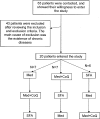Mediterranean diet supplemented with coenzyme Q10 induces postprandial changes in p53 in response to oxidative DNA damage in elderly subjects
- PMID: 21404051
- PMCID: PMC3312623
- DOI: 10.1007/s11357-011-9229-1
Mediterranean diet supplemented with coenzyme Q10 induces postprandial changes in p53 in response to oxidative DNA damage in elderly subjects
Abstract
Coenzyme Q10 (CoQ) is a powerful antioxidant that reduces oxidative stress. We explored whether the quality of dietary fat alters postprandial oxidative DNA damage and whether supplementation with CoQ improves antioxidant capacity by modifying the activation/stabilization of p53 in elderly subjects. In this crossover study, 20 subjects were randomly assigned to receive three isocaloric diets during 4 weeks each: (1) Mediterranean diet (Med diet), (2) Mediterranean diet supplemented with CoQ (Med+CoQ diet), and (3) saturated fatty acid-rich diet (SFA diet). Levels of mRNAs were determined for p53, p21, p53R2, and mdm2. Protein levels of p53, phosphorylated p53 (Ser20), and monoubiquitinated p53 were also measured, both in cytoplasm and nucleus. The extent of DNA damage was measured as plasma 8-OHdG. SFA diet displayed higher postprandial 8-OHdG concentrations, p53 mRNA and monoubiquitinated p53, and lower postprandial Mdm2 mRNA levels compared with Med and Med+CoQ diets (p < 0.05). Moreover, Med+CoQ diet induced a postprandial decrease of cytoplasmatic p53, nuclear p-p53 (Ser20), and nuclear and cytoplasmatic monoubiquitinated p53 protein (p < 0.05). In conclusion, Med+CoQ diet improves oxidative DNA damage in elderly subjects and reduces processes of cellular oxidation. Our results suggest a starting point for the prevention of oxidative processes associated with aging.
Figures





Similar articles
-
Postprandial antioxidant gene expression is modified by Mediterranean diet supplemented with coenzyme Q(10) in elderly men and women.Age (Dordr). 2013 Feb;35(1):159-70. doi: 10.1007/s11357-011-9331-4. Epub 2011 Nov 6. Age (Dordr). 2013. PMID: 22057896 Free PMC article. Clinical Trial.
-
Postprandial antioxidant effect of the Mediterranean diet supplemented with coenzyme Q10 in elderly men and women.Age (Dordr). 2011 Dec;33(4):579-90. doi: 10.1007/s11357-010-9199-8. Epub 2010 Dec 18. Age (Dordr). 2011. PMID: 21170684 Free PMC article. Clinical Trial.
-
Postprandial activation of p53-dependent DNA repair is modified by Mediterranean diet supplemented with coenzyme Q10 in elderly subjects.J Gerontol A Biol Sci Med Sci. 2014 Jul;69(7):886-93. doi: 10.1093/gerona/glt174. Epub 2013 Oct 24. J Gerontol A Biol Sci Med Sci. 2014. PMID: 24158762 Clinical Trial.
-
Micronutrient special issue: coenzyme Q(10) requirements for DNA damage prevention.Mutat Res. 2012 May 1;733(1-2):61-8. doi: 10.1016/j.mrfmmm.2011.09.004. Epub 2011 Sep 22. Mutat Res. 2012. PMID: 21964355 Review.
-
Coenzyme Q and Its Role in the Dietary Therapy against Aging.Molecules. 2016 Mar 18;21(3):373. doi: 10.3390/molecules21030373. Molecules. 2016. PMID: 26999099 Free PMC article. Review.
Cited by
-
Coenzyme Q10 rescues ethanol-induced corneal fibroblast apoptosis through the inhibition of caspase-2 activation.J Biol Chem. 2013 Apr 26;288(17):11689-704. doi: 10.1074/jbc.M112.401844. Epub 2013 Feb 19. J Biol Chem. 2013. PMID: 23430247 Free PMC article.
-
Potential application of the oxidative nucleic acid damage biomarkers in detection of diseases.Oncotarget. 2017 Sep 8;8(43):75767-75777. doi: 10.18632/oncotarget.20801. eCollection 2017 Sep 26. Oncotarget. 2017. PMID: 29088908 Free PMC article. Review.
-
Postprandial antioxidant gene expression is modified by Mediterranean diet supplemented with coenzyme Q(10) in elderly men and women.Age (Dordr). 2013 Feb;35(1):159-70. doi: 10.1007/s11357-011-9331-4. Epub 2011 Nov 6. Age (Dordr). 2013. PMID: 22057896 Free PMC article. Clinical Trial.
-
Postprandial Antioxidative Response to Ingestion of Formulated Date- and Fruit-Based Nutritional Bars by Healthy Individuals.Nutrients. 2024 Jun 6;16(11):1794. doi: 10.3390/nu16111794. Nutrients. 2024. PMID: 38892726 Free PMC article.
-
The Effect of Nutrition on Aging-A Systematic Review Focusing on Aging-Related Biomarkers.Nutrients. 2022 Jan 27;14(3):554. doi: 10.3390/nu14030554. Nutrients. 2022. PMID: 35276919 Free PMC article.
References
Publication types
MeSH terms
Substances
LinkOut - more resources
Full Text Sources
Medical
Molecular Biology Databases
Research Materials
Miscellaneous
